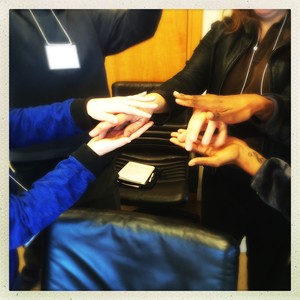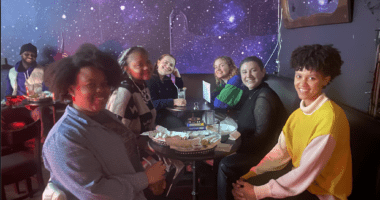Community-Word Project’s Teaching Artist Training & Internship Program (TATIP) reconvened for the second installment of the Saturday professional development seminars on Halloween 2015 for a spooktacular day of model lesson planning and learning objectives exploration. The workshop was held at the offices of Skadden, Arps, Slate, Meagher & Flom in Times Square, courtesy of CWP Board Member Andrea Nicolas. Thank you, Andrea! It was incredible to look down at the New Year’s Eve crystal ball from our glamorous perch on the 38th floor!

We opened with a Graffiti Walls ritual, asking participants to write responses to statements posed around the room, such as “The most memorable class I had in high school…”, “Challenges I face when planning lessons…” and “I learn best when…”. This activity provided the foundation for the day’s topics and helped the participants think about what it means to design a thoughtfully scaffolded, impactful lesson.

The lead facilitators, Patti Chilsen and Renée Watson asked the participants to become students in a Model Lesson. They began with a common struggle amoung young writers: Sensory Details. Sensory Details are descriptions of nouns using the five senses to enhance the writing. Renée discussed what it meant to use the five senses and passed out a chart containing images and a blank column for each one. Then, as an expert example of using this device, we looked at the poem “Raised by Women” by Kelly Norman Ellis, author of Tougaloo Blues (2003) and Offerings of Desire (2012). Participants took turns reading the stanzas aloud, adding gestures to illustrate the poem using bodily intelligence. They also examined photographs that illustrated various images in the poems, from types of women to food mentioned in the text.

We listened to James Brown’s “Say it Loud – I’m Black and I’m Proud” to enhance the reading and build on the energy in the room. Next, the participants were asked to think about their own childhoods and write down notes on the sensory detail charts about their memories. These prompts led the participants to write poems about their childhoods based on their sensory details.

Rounding out the morning session, Patti and Renée changed the lesson from a writing exercise to a collaborative performance piece. Each participant selected their favorite line from their individual poem and then broke into six groups. The groups were given time to combine their sentences and create a collaborative performance piece from their efforts. Besides being provided a performance recipe as a guiding tool, each group was assigned a different “secret ingredient” to integrate into their creative pieces. The end products were astonishing.




After the performances, the group reflected on the lesson as a whole, breaking down everything from the exercises to the way Patti and Renée worked together to implement the lesson.

In the afternoon session, Patti and Renée split the Advanced and New & Beginning/Student Trainees and worked with them separately. The Advanced Trainees met with Renée to talk about the successes and challenges in their work to date, and to focus on what it takes to create a strong Teaching Path (curriculum) for an arts residency.

Separately Patti had the New & Beginning/Student Trainees break down the basics of creating a strong lesson plan. She talked about the morning’s lesson that she and Renée modeled, reviewing each layer to show how an impactful lesson will scaffold its objectives and build layers in order to best reach each student. The group discussed a formula for Inquiry Questions and how to shape strong ones that keep the goals linked to the activities.

We ended the day with Halloween candy and a discussion about the TATIP program, highlighting essential requirements and breaking down the internship component. Each trainee received their internship assignment the day prior and virtually met their mentors. The trainees will begin their internships in the coming weeks, branching out into the various CWP residencies around New York City.
Next session we will talk about a variety of topics including student assessment and the developmental process. Trainees will also be assigned their TATIP partners and will begin working on a lesson plan to implement in the classroom. Stay tuned for the next installment!



